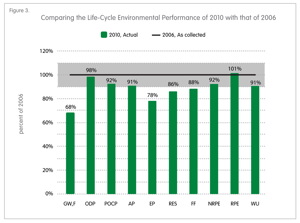Corrugated Study Shows Environmental Gains
- Published: June 09, 2014
ELK GROVE VILLAGE, IL | A new US corrugated industry life cycle assessment (LCA) study shows what is called a significant 32% reduction per unit in the industry's greenhouse gas (GHG) emissions between 2006 and 2010. Additionally, the industry improved in other environmental impact indicators. Effects of nutrient releases on receiving waters and soils (eutrophication) decreased by 22%, and effects of particulate matter emissions (respiratory effects) decreased by 14%. 
These results are from a peer-reviewed study commissioned by the Corrugated Packaging Alliance (CPA) and conducted by the National Council for Air and Stream Improvement (NCASI).
The study measures the environmental impacts of a 1-kg industry-average corrugated product manufactured in 2010 and shows substantial improvements over the industry-average product manufactured in 2006, as reported in the industry's first baseline LCA.
The reduction in GHG emissions per unit is attributed primarily to the increased recovery for recycling of corrugated materials. The recovery rate for old corrugated containers (OCC) increased from 72% in 2006 to 85% in 2010. As more corrugated material is recovered, less goes to landfills, thereby reducing methane emissions.
Containerboard mills also helped reduce GHG emissions by decreasing the overall use of fossil fuels and switching to less carbon-intensive fuels like natural gas.
Dennis Colley, (http://www.linkedin.com/pub/dennis-j-colley/44/86a/253) executive director of the CPA, says, "We're very pleased about our reduced greenhouse gas emissions and overall environmental impact reductions, driven by our industry's historic commitment to continuous improvement and environmental stewardship. We've been proactively improving on our environmental footprint for decades, and through the use of LCA, we're able to document the results of our efforts."
The study also examined the relative impacts of industry-average corrugated products (which contained 46% recycled fiber) and 100% recycled corrugated products made in 2010. Corrugated products can be made from 100% new fiber, 100% recycled fiber, or a blend of these fibers. All types of fiber have benefits and contribute to maintaining a sustainable corrugated packaging industry, says the study.
The LCA showed that both the 100% recycled and industry-average corrugated products have environmental advantages in different impact categories. Reportedly, one is not better than the other across all environmental impact indicators, and the corrugated industry must maintain a supply of new fiber to augment those fibers that are recovered and used for production. The worldwide market needs both new and recycled fiber in order to produce the best quality of corrugated material and ensure a consistent and sustainable supply. The LCA examined effects on seven environmental impact indicators: global warming potential (greenhouse gas emissions), eutrophication, acidification, smog, ozone depletion, respiratory effects, fossil fuel depletion; and four inventory indicators: water use, water consumption, renewable energy demand, and non-renewable energy demand. It was conducted in accordance with ISO 14040/44 standards and guidelines for LCA studies and was subjected to review by a third-party critical review panel.
This email address is being protected from spambots. You need JavaScript enabled to view it.




